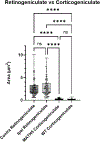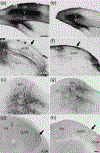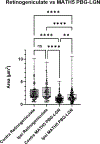The parabigeminal nucleus is a source of "retinogeniculate replacement terminals" in mice that lack retinofugal input
- PMID: 36066425
- PMCID: PMC9588688
- DOI: 10.1002/cne.25401
The parabigeminal nucleus is a source of "retinogeniculate replacement terminals" in mice that lack retinofugal input
Abstract
In the dorsal lateral geniculate nucleus (LGN) of mice that lack retinal input, a population of large terminals supplants the synaptic arrangements normally made by the missing retinogeniculate terminals. To identify potential sources of these "retinogeniculate replacement terminals," we used mutant mice (math5-/- ) which lack retinofugal projections due to the failure of retinal ganglion cells to develop. In this line, we labeled LGN terminals that originate from the primary visual cortex (V1) or the parabigeminal nucleus (PBG), and compared their ultrastructure to retinogeniculate, V1 or PBG terminals in the dLGN of C57Blk6 (WT) mice (schematically depicted above graph). Corticogeniculate terminals labeled in WT and math5-/- mice were similar in size and both groups were significantly smaller than WT retinogeniculate terminals. In contrast, the PBG projection in math5-/- mice was extensive and there was considerable overlap in the sizes of retinogeniculate terminals in WT mice and PBG terminals in math5-/- mice (summarized in histogram). The data indicate that V1 is not a source of "retinogeniculate replacement terminals" and suggests that large PBG terminals expand their innervation territory to replace retinogeniculate terminals in their absence.
Keywords: RpB4-cre; corticogeniculate; dorsal lateral geniculate nucleus; math5-/-; pedunculopontine tegmentum; synapse; tectogeniculate; ultrastructure.
© 2022 Wiley Periodicals LLC.
Conflict of interest statement
Conflict of interest: The authors declare no competing financial interests.
Figures










References
Publication types
MeSH terms
Grants and funding
LinkOut - more resources
Full Text Sources
Molecular Biology Databases

